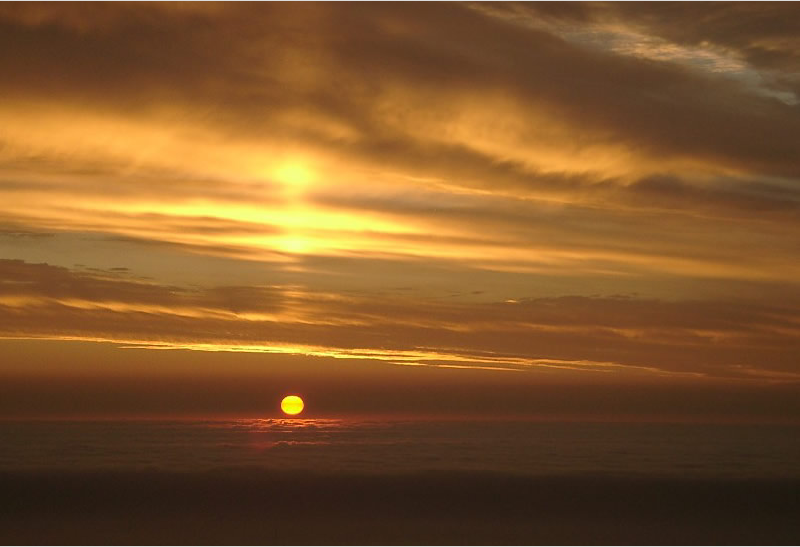Sun Pillar from Paranal ESO Observatory
Sun Pillar from Paranal ESO Observatory: A Spectacular Atmospheric Phenomenon
Have you ever witnessed a stunning celestial display that left you in awe? One such captivating phenomenon is the Sun Pillar, a vertical column of light that extends above or below the sun. This optical spectacle can be observed under specific atmospheric conditions and is a sight to behold. In this article, we will delve into the intricacies of a Sun Pillar as observed from the Paranal ESO Observatory in the Chilean Atacama Desert.
The Paranal ESO Observatory: A Window to the Skies
Perched at an elevation of 2400 meters, the Paranal European Southern Observatory (ESO) in the Chilean Atacama Desert offers an ideal vantage point for astronomers and sky gazers alike. This renowned observatory boasts pristine skies and minimal light pollution, providing a clear canvas for observing celestial phenomena. The Paranal ESO Observatory has captured many breathtaking images, including one of a mesmerizing Sun Pillar.
Unveiling the South American Sun Pillar
The photograph taken by Sylvain Rondi at the Paranal ESO Observatory showcases a remarkable South American Sun Pillar. This ethereal spectacle occurs when sunlight interacts with ice crystals present in the Earth's atmosphere. While the sun is setting over the Pacific Ocean, the waves visible in the image are not actual ocean waves but rather cloud formations covering the ocean surface.
The Science Behind the Sun Pillar
To understand the formation of a Sun Pillar, we must delve into the science of atmospheric optics. When sunlight passes through ice crystals suspended in the air, it undergoes a process called refraction. The ice crystals act as tiny prisms, bending the light rays and causing them to separate into different colors. This dispersion creates a stunning vertical column of light that appears to extend above or below the sun.
Atmospheric Conditions Conducive to Sun Pillar Formation
Several atmospheric conditions are necessary for the formation of a Sun Pillar. Firstly, there must be a sufficient presence of ice crystals in the atmosphere. These ice crystals can originate from high-altitude clouds, such as cirrus clouds, or even from frozen water droplets in lower-level clouds. Secondly, the orientation of the ice crystals must be relatively uniform to create a coherent pillar of light.
Sun Pillar Variations and Optical Illusions
While the classic Sun Pillar appears as a vertical column extending from the sun, variations and optical illusions can occur, adding to the intrigue of this phenomenon. Sometimes, the pillar may appear slanted or even curved due to the orientation of the ice crystals. Additionally, if the ice crystals are irregularly shaped, they can create false pillars or multiple pillars, creating a captivating display of light in the sky.
The Role of Observatories in Documenting Atmospheric Phenomena
Observatories like the Paranal ESO Observatory play a crucial role in documenting and studying atmospheric phenomena such as Sun Pillars. By capturing high-quality images and data, astronomers and scientists can further unravel the mysteries of these optical wonders. The Paranal ESO Observatory's strategic location in the Chilean Atacama Desert provides an optimal environment for observing and studying celestial events.
Appreciating Nature's Spectacles
Witnessing a Sun Pillar from the Paranal ESO Observatory is a reminder of the wonders of our natural world. It serves as a testament to the beauty and complexity of atmospheric optics. These ephemeral displays remind us to pause and appreciate the intricate interactions between sunlight, ice crystals, and Earth's atmosphere that create such captivating visual phenomena.
Capturing Your Own Glimpse of Atmospheric Marvels
While not everyone may have the opportunity to visit observatories like the Paranal ESO Observatory, anyone can marvel at atmospheric marvels in their own surroundings. By keeping an eye on the sky and learning about different atmospheric phenomena, we can increase our chances of witnessing these captivating displays firsthand. Whether it's a Sun Pillar, a rainbow, or a halo, nature's spectacles are waiting to be discovered and appreciated by all.
Conclusion
The Sun Pillar observed from the Paranal ESO Observatory in the Chilean Atacama Desert is a testament to the awe-inspiring beauty of atmospheric optics. Through the interplay of sunlight and ice crystals, this vertical column of light emerges, captivating observers with its ethereal presence. As we continue to explore and study the complexities of our atmosphere, let us cherish these fleeting moments of celestial wonder and appreciate the intricate dance of light in our skies.

South American Sun Pillar. The sun is setting over the Pacific but the waves visible are those in a cloud deck covering the ocean. Sylvain Rondi (site) took this image from an elevation of 2400m at the Paranal, European Southern Observatory in the Chilean Atacama Desert. ©2002 Sylvain Rondi
Note: this article has been automatically converted from the old site and may not appear as intended. You can find the original article here.
Reference Atmospheric Optics
If you use any of the definitions, information, or data presented on Atmospheric Optics, please copy the link or reference below to properly credit us as the reference source. Thank you!
-
<a href="https://atoptics.co.uk/blog/sun-pillar-from-paranal-eso-observatory/">Sun Pillar from Paranal ESO Observatory </a>
-
"Sun Pillar from Paranal ESO Observatory ". Atmospheric Optics. Accessed on November 26, 2024. https://atoptics.co.uk/blog/sun-pillar-from-paranal-eso-observatory/.
-
"Sun Pillar from Paranal ESO Observatory ". Atmospheric Optics, https://atoptics.co.uk/blog/sun-pillar-from-paranal-eso-observatory/. Accessed 26 November, 2024
-
Sun Pillar from Paranal ESO Observatory . Atmospheric Optics. Retrieved from https://atoptics.co.uk/blog/sun-pillar-from-paranal-eso-observatory/.